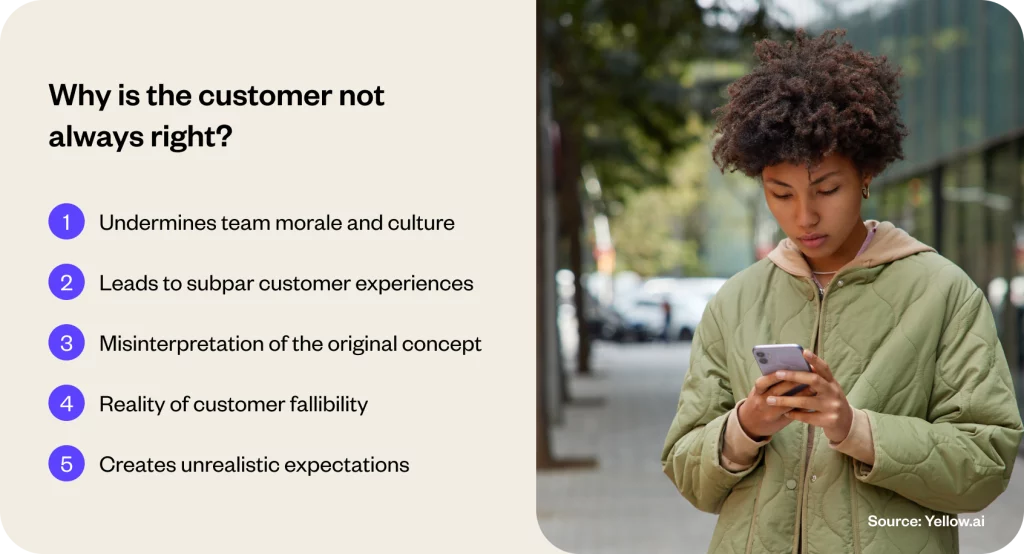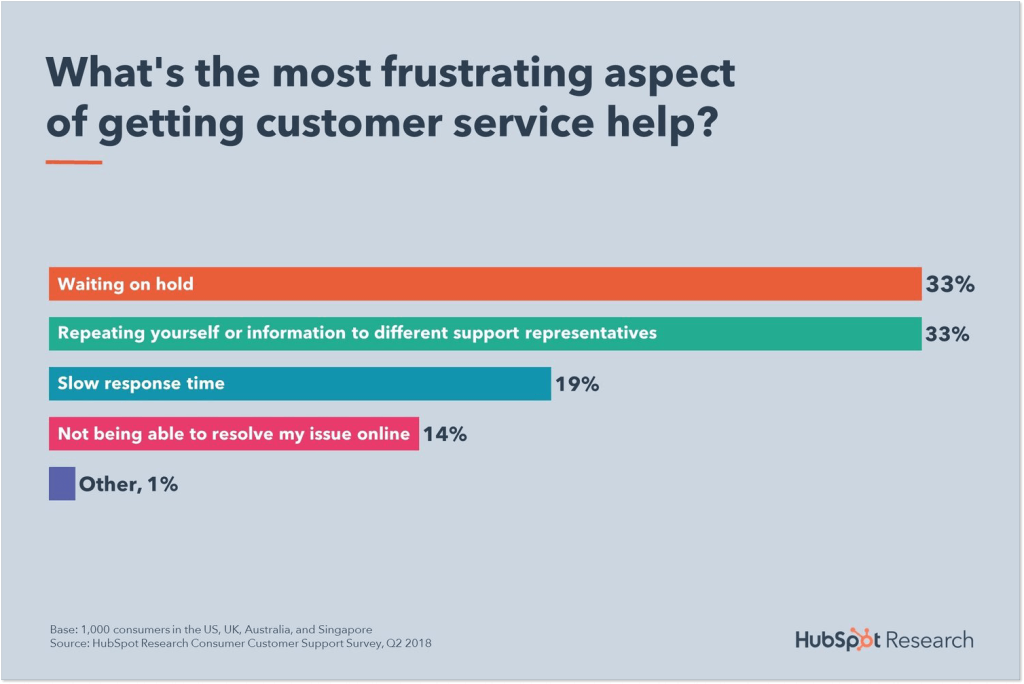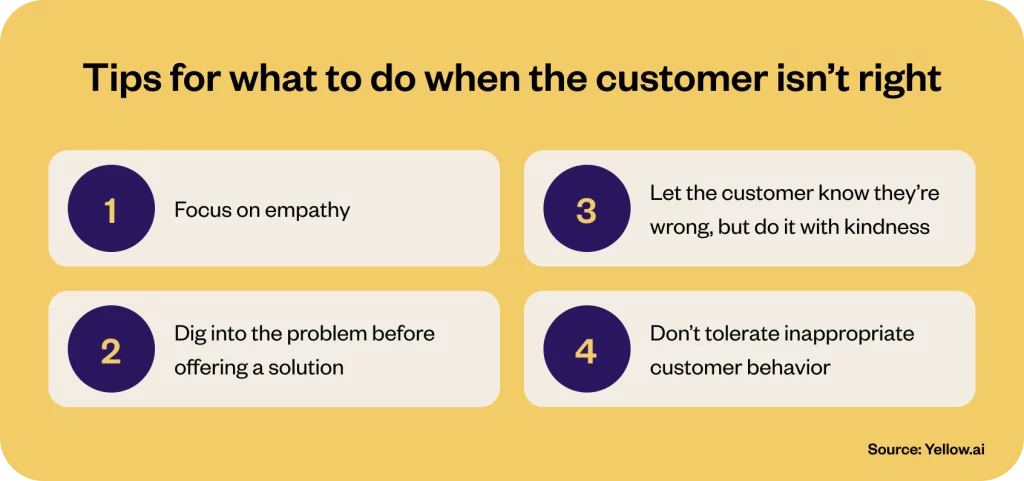Executive summary
Dive into the surprising truths behind the customer service maxim “the customer is always right.” This blog on why the customer is not always right explores the hidden impacts of this belief on business dynamics. It illustrates why a more balanced approach can lead to healthier relationships between companies and their clients. Discover how nuanced customer service strategies can enhance team morale, improve service quality, and align with realistic business practices.
The age-old saying “the customer is always right” has echoed through the halls of businesses for decades, guiding service with a customer-first mantra. But is it an infallible truth? This blog dares to question the hypothesis, proposing that there are indeed surprising instances where the customer may not hold all the cards. It’s a narrative that unfolds the complexities of customer relations, suggesting that a more nuanced approach could lead to healthier outcomes for both businesses and their patrons.
As we peel back the layers of this customer service doctrine, we’ll delve into its origins, dissect its intentions, and reveal its impact on today’s business practices. With a mix of anecdotal evidence and practical insights, this exploration aims to offer a fresh perspective, challenging business owners and service professionals to rethink their strategies for customer engagement. Besides just debunking the myth, it is about fostering a dialogue that champions respect, understanding, and realistic expectations in the world of commerce.
Is the customer always right?
The customer is always right” might sound like a golden rule in business, but is it an absolute truth? This phrase has been a customer service mantra for over a century, suggesting that customer satisfaction should be a company’s top priority. However, the real business world often presents a more complex scenario. While it’s essential to value and prioritize customer feedback, embracing this saying without question can lead to unrealistic expectations and compromise the well-being of employees.
Businesses are increasingly recognizing that a balanced approach, which respects both the customer’s voice and the company’s integrity, leads to healthier outcomes. This nuanced perspective supports sustainable business practices where decisions are guided by fairness and practicality, not just by the customer’s demands.
Origin of ‘The customer is always right.’
The mantra “the customer is always right” might sound like a modern-day customer service commandment, but its roots go way back to retail legends like Harry Gordon Selfridge and Marshall Field. These guys were the retail rockstars of the early 1900s, flipping the script on customer service. Instead of the “buyer beware” vibe, they rolled out the red carpet for shoppers, treating them like royalty even if they weren’t always right. It was a big deal back then, changing the game for how shops treated folks walking through their doors. It was all about respect and making customers feel special, which turned out to be a brilliant move for business.
Why is the customer not always right?
Grasping the truth that the customer isn’t always right can be a pivotal shift for businesses. Here’s a closer look at why this mantra may not always hold water:

1. Undermines team morale and culture
The notion that the customer is always right can sometimes place employees in a tough spot, especially if they have to deal with unreasonable demands. This stance can make staff feel their expertise and insights are undervalued, leading to frustration and diminished morale.
Prioritizing customers’ opinions over those of your employees can create a rift within the team, causing a culture where staff feel less engaged and appreciated. Businesses thrive when employees feel their contributions are valued, leading to a more motivated and cohesive workforce.
2. Leads to subpar customer experiences
Focusing too much on satisfying every customer demand, regardless of its reasonableness, can detract from the overall quality of service provided to others. Resources may become stretched thin, impacting the business’s ability to serve a larger customer base effectively.
Ensuring a balanced approach, where customer demands are weighed against the overall service strategy, can lead to more sustainable and high-quality customer interactions. This balance helps maintain a high standard of service across the board, ensuring all customers receive the attention and quality they deserve.

The most frustrating aspect of customer service
3. Misinterpretation of the original concept
The original sentiment behind “the customer is always right” was about showing customers respect and value, not blind acquiescence to their every demand. As consumer rights and business practices have evolved, so should this phrase’s interpretation.
A literal application of this mantra in today’s context can lead to unrealistic expectations and unsustainable practices. Businesses need to adapt this concept to fit modern customer service paradigms, focusing on respect, value, and mutual understanding.
4. Reality of customer fallibility
Accepting that customers can be mistaken or have misconceptions allows businesses to engage in more meaningful and constructive interactions. This understanding provides an opportunity to educate and guide customers effectively.
Addressing customer misunderstandings with patience and clarity can help build stronger relationships and enhance customer loyalty. It’s about finding the balance between accommodating customer needs and maintaining the integrity of your business practices.
Look at this bar chart that compares customers’ actions after a very good and bad experience.

5. Creates unrealistic expectations
Adhering too strictly to the idea that the customer is always right can create unattainable expectations, potentially leading to disappointment and perceived failure. It’s crucial for businesses to set realistic boundaries and clear guidelines for interactions.
By managing customer expectations and clearly communicating what is feasible, businesses can prevent overcommitment and under-delivery, ensuring a more consistent and reliable customer experience.
Tips for what to do when the customer isn’t right
When navigating the tricky waters where the customer isn’t right, businesses can maintain a respectful yet firm stance. Here’s how to handle such situations with tact and professionalism:

Related read: How to deal with difficult customers: 15 tips + Examples
1. Focus on empathy
Embrace empathy as a core approach when dealing with customers. This means actively listening and genuinely understanding their concerns, regardless of the situation’s validity.
Tips
- Listen more than you speak to understand the customer’s perspective.
- Acknowledge their feelings and validate their experience.
- Avoid interrupting or dismissing their concerns.
Empathy can transform a potentially negative interaction into a positive one. For instance, a customer who is frustrated over a misunderstood policy may feel valued and heard when their concerns are met with empathy, leading to increased loyalty and a resolution that suits both parties.
2. Dig into the problem before offering a solution
Analyze the customer’s issue thoroughly before jumping to conclusions or solutions. It involves asking probing questions to understand the root cause of their dissatisfaction.
Tips
- Clarify the customer’s needs by asking detailed questions.
- Avoid making assumptions based on initial information.
- Summarize their points to ensure mutual understanding.
By digging deeper, businesses can identify the actual problem, leading to more effective and satisfying solutions. For example, a customer upset about a product feature might need guidance on using it effectively. Proper education on the product and support can address this.
3. Let the customer know they’re wrong, but do it with kindness
When customers are mistaken, communicate the correct information with kindness and respect, ensuring they don’t feel belittled or embarrassed.
Tips
- Use gentle language and tone to correct misinformation.
- Provide clear evidence or explanations to support your point.
- Express willingness to help resolve any misunderstandings.
Correcting a customer kindly can lead to a positive experience, where they appreciate honesty and assistance. For instance, if a customer has a wrong perception of a service, clarifying this with kindness can enhance their understanding and trust in your business.
4. Don’t tolerate inappropriate customer behavior
Set clear boundaries for acceptable customer behavior and enforce them to protect employees and maintain a respectful environment.
Tips
- Communicate your business’s behavioral expectations clearly.
- Take decisive action when boundaries are crossed.
- Support and defend employees against inappropriate behavior.
Enforcing behavioral standards ensures a safe and positive environment for both staff and customers. An example would be a situation where a customer’s aggressive behavior is met with a firm yet respectful response, signaling that while business is valued, respect is non-negotiable.
How to maintain a customer-first mentality
Maintaining a customer-first mentality is crucial for businesses aiming to foster loyalty and achieve long-term success. Here’s how companies can keep this perspective at the forefront of their operations:

1. Empower customers for successful outcomes
Empowerment involves giving customers the tools and resources they need to resolve their issues independently or with minimal assistance.
Tips
- Provide comprehensive self-service options, like FAQs and how-to guides.
- Equip customer service agents with the authority to make decisions that benefit the customer.
- Offer training and resources to customers to improve their understanding and usage of your products or services.
Empowering customers enhances their sense of control and satisfaction with the service. For example, a tech company offering detailed tutorials and a responsive self-service portal allows customers to troubleshoot issues quickly, reducing frustration and support calls.
2. Adjust expectations to align with realistic outcomes
Setting realistic expectations helps manage customer perceptions and ensure they are aligned with what the business can deliver.
Tips
- Communicate clearly about what customers can expect in terms of product functionality, support response times, and service delivery.
- Train staff to convey realistic outcomes and timelines to customers.
- Regularly review and adjust your company’s promises to ensure they are achievable.
When customers have realistic expectations, they are more likely to be satisfied with the service. For instance, a delivery company providing accurate estimates of shipping times sets clear expectations, reducing customer complaints about delays.
3. Foster a culture centered around customer needs
Creating a company culture that prioritizes customer needs ensures that every decision and action contributes to customer satisfaction.
Tips
- Encourage employees to think from the customer’s perspective in their daily tasks.
- Recognize and reward staff who go the extra mile to meet customer needs.
- Regularly gather and act on customer feedback to improve services.
A customer-centric culture enhances customer loyalty and business growth. For example, a restaurant that consistently listens to and acts on customer feedback can improve its menu and service, leading to repeat business and positive reviews.
Related read: How to Improve Customer Satisfaction in 2024?
4. Maintain clarity and simplicity in communications
Clear and straightforward communication is critical to avoiding misunderstandings and ensuring customers have a good understanding of your products and services.
Tips
- Use simple, jargon-free language in all customer communications.
- Ensure transparency in terms and conditions, pricing, and policies.
- Provide easy-to-understand instructions and information about your products or services.
Clarity in communication builds trust and reduces customer confusion. For instance, a financial services company that explains its loan process in clear terms can help customers make informed decisions, enhancing their experience and trust in the company.
5. Acknowledge the diversity in customer experiences
Recognizing that each customer is unique and may have different needs and preferences is essential for providing personalized service.
Tips
- Segment your customer base to tailor services and communications to different groups.
- Train staff to adapt their approach based on individual customer interactions.
- Use customer data to understand and anticipate diverse needs.
Acknowledging and catering to the diversity of customer experiences can lead to increased satisfaction and loyalty. For example, a retailer that offers personalized shopping experiences based on past purchases and preferences can create a more engaging and satisfying experience for customers, encouraging repeat business and positive word-of-mouth.
Empower your customers with a support experience like no other

The final thoughts
Navigating customer relationships is akin to a two-way street, not just a one-way directive that the customer is always right. In business, saying “the customer is not always right” isn’t about dismissing their importance. Instead, it is about fostering genuine, respectful, and mutually beneficial interactions. In the realm of commerce, success hinges on this balanced engagement, where the voices of both customers and employees are valued and heard.
Yellow.ai steps in as a beacon of balance, offering AI-driven solutions that don’t just appease but truly understand and address the needs of both sides. Our technology bridges between customer expectations and business realities, ensuring every interaction is a step toward shared success.
As we close this discussion, let’s remember that every step counts in the intricate realities of business. With partners like Yellow.ai, businesses can navigate the challenges with prowess , ensuring that each move is in sync with the rhythm of customer satisfaction and operational excellence. Here’s to moving forward with insight, empathy, and the right tools in hand, crafting a narrative where everyone feels acknowledged and valued.






















